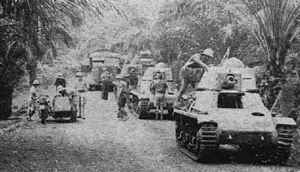Dates 8 Nov 1940 – 12 Nov 1940 | Result Allied victory | |
 | ||
Similar World War II, Battle of Dakar, Battle of Réunion, Battle of Madagascar, Mediterranean and Middle East theat | ||
Battle of gabon
The Battle of Gabon (French: bataille du Gabon), also called the Gabon Campaign (campagne du Gabon) or the Battle of Libreville, was part of the fighting in French West Africa that occurred in November 1940 as part of World War II. The battle resulted in the Free French Forces taking the colony of Gabon and its capital, Libreville, from Vichy French forces.
Contents
- Battle of gabon
- 1940 battle of gabon
- Background
- Prelude
- Battle
- Aftermath
- Free French
- United Kingdom
- Vichy French
- References
1940 battle of gabon
Background
On the evening of 28 August, 1940, Governor Georges Masson pledged Gabon's allegiance to Free France. He met immediate opposition from much of Libreville's French population and from Gabon's influential bishop, Louis Tardy, who favoured Vichy France's conservative policies. Facing pressure, Masson was forced to rescind his pledge. Free French sympathizers were arrested by the colonial administration and imprisoned on board the auxiliary cruiser Cap des Palmes.
Prelude
On 8 October 1940, General de Gaulle arrived in Douala, in French Cameroon. On 12 October, he authorised plans for the invasion of French Equatorial Africa. De Gaulle also wanted to use French Equatorial Africa as a base to launch attacks into Axis-controlled Libya. For this reason, he personally headed northward to survey the situation in Chad, located on the southern border of Libya.
On 27 October, Free French forces crossed into French Equatorial Africa and took the town of Mitzic. On 5 November, the Vichy garrison at Lambaréné capitulated. Meanwhile, the main Free French forces under General Philippe Leclerc and Battalion Chief (major) Marie Pierre Koenig departed from Douala, French Cameroon. Their goal was to take Libreville, French Equatorial Africa. The British expressed doubt in De Gaulle's ability to establish control over the Vichy territory, but they eventually agreed to lend naval support to the Free French.
Battle
On 7 November 1940, the Shoreham-class sloop HMS Milford discovered the Vichy Redoutable-class submarine Poncelet shadowing the Anglo-French task force and gave chase. The sloop was too slow to intercept the submarine, so Admiral Cunningham ordered his flagship, HMS Devonshire, to launch its Supermarine Walrus biplane. Piloted by David Corkhill, the aircraft straddled the submarine with two salvos of 100 lb depth charges as it attempted to dive, damaging it. It was then scuttled off Port-Gentil. Koenig's forces landed at Pointe La Mondah on the night of 8 November. His forces included French Legionnaires (including the 13th Foreign Legion Demi-Brigade), Senegalese and Cameroonian troops.
On 9 November, Free French Westland Lysander aircraft operating out of Douala bombed Libreville aerodrome. The aerodrome was eventually captured, despite stiff resistance met by Koenig's force in its approach. Free French naval forces consisting of the minesweeper Commandant Dominé and the cargo vessel Casamance were led by Georges Thierry d'Argenlieu aboard the Bougainville-class aviso Savorgnan de Brazza in conducting coastal operations. De Brazza attacked and sank her sister ship, the Vichy French Bougainville. Libreville was captured on 10 November.
On 12 November, the final Vichy forces at Port Gentil surrendered without a fight. Governor Masson — despairing of his actions — committed suicide.
Aftermath
On 15 November, de Gaulle made a personal appeal that failed to persuade most of the captured Vichy soldiers — including General Marcel Tetu — to join the Free French. As a result, they were interned as prisoners of war in Brazzaville, French Congo for the duration of the war.
With their control consolidated in Equatorial Africa, the Free French began focusing on the campaign in Italian Libya. De Gaulle relieved General Leclerc of his station in Cameroon and sent him to Fort Lamy, Chad to oversee offensive preparations.
The conflict in Gabon triggered a mass migration of Gabonese to Spanish Guinea. French Equatorial Africa cut its ties with the Vichy-controlled West African territories, and rebuilt its economy around trade with nearby British possessions, namely Nigeria. Tensions remained long after the invasion between Vichy-sympathizers and the new administration. The seizure of Gabon and the rest of French Equatorial Africa gave Free France new-found legitimacy. No longer was it an organization of exiles in Britain, as it now had its own sizable territory to govern.
